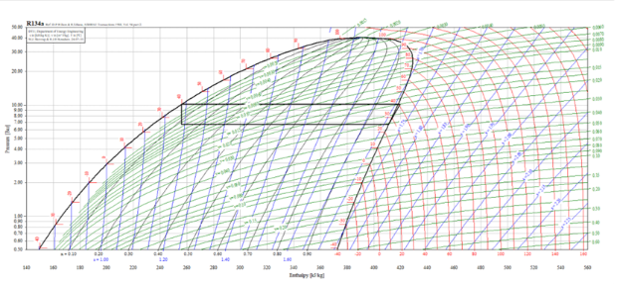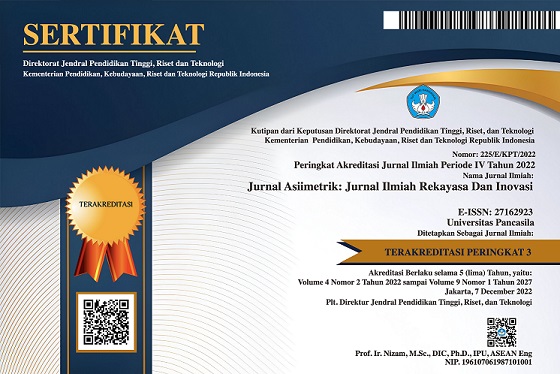Performance Analysis of H2O-LiBr Absorption Refrigeration Systems for Future Cars
DOI:
https://doi.org/10.35814/asiimetrik.v7i2.8142Keywords:
absorption, alternative, H2O-LiBr, performance, refrigerationAbstract
There has been an increase in the development of electric cars in recent decades, driven by the global need to reduce greenhouse gas emissions and air pollution. The use of refrigeration systems in electric cars is one of the largest consumptions of electric power. Therefore, this study used an absorption refrigeration system with a working fluid in the form of a combination of water as a refrigerant and lithium bromide salt as an absorption compound (H2O-LiBr) as an alternative refrigeration system.However, the use of water as a refrigerant leads to the required components being larger. This study focuses on analyzing the work performance of absorption refrigeration systems. The results of the analysis of the performance of the absorption refrigeration system state that to get the optimal performance value in operating the designed H2O-LiBr absorption refrigeration system, the generator outlet temperature is required to be a minimum of 75°C, which produces a performance stated in COP of 0.705. In the meantime, the analysis of the generator outlet temperature's impact on the refrigeration system's performance value revealed that the higher the generator outlet temperature, the higher the performance value.
Downloads
References
Alanazi, F. (2023) ‘Electric Vehicles: Benefits, Challenges, and Potential Solutions for Widespread Adaptation’, Applied Sciences, 13(10), p. 6016. Available at: https://doi.org/10.3390/app13106016.
ASHARE (2013) 2013 ASHRAE Handbook: Fundamentals. UK: American Society of Heating, Refrigerating and Air-Conditioning Engineers. [Print].
Assad, M.E.H. et al. (2021) ‘Space Cooling Using Geothermal Single-Effect Water/Lithium Bromide Absorption Chiller’, Energy Science & Engineering, 9(10), pp. 1747–1760. Available at: https://doi.org/10.1002/ese3.946.
Boles, M.A. and Cengel, Y.A. (2014) Thermodynamics: An Engineering Approach. 8th edn. India: McGraw-Hill Education. [Print].
Budi, A.N.S., Qiram, I. and Sartika, D. (2021) ‘Pengaruh Prosentase Kepekatan Kaca Film Terhadap Distribusi Termal dan Pencahayaan Kabin Kendaraan’, V-MAC (Virtual of Mechanical Engineering Article), 6(1), pp. 1–4. Available at: https://doi.org/10.36526/v-mac.v6i1.1293.
Hashim, N.A. and Kassim, M.S. (2020) ‘A Comparative Study About Lithium Bromide-Water and Lithium Chloride-Water Solutions in Pumpless Absorption Solar Cooling Systems in Iraqi Circumstances’, Journal of Engineering and Sustainable Development, 24(4), pp. 79–88. Available at: https://doi.org/10.31272/jeasd.24.4.9.
Hashim, N.A. and Kassim, M.S. (2021) ‘Experimental Study of A LiCl-H2O Bubble Pump Solar Absorption Cooling System’, in IOP Conference Series: Materials Science and Engineering. 1st International Conference on Sustainable Engineering and Technology (INTCSET 2020), Baghdad, Iraq: IOP Publishing Ltd, p. 012017. Available at: https://doi.org/10.1088/1757-899X/1094/1/012017.
Holman, J.P. (2009) Heat Transfer. Colombia: McGraw-Hill Education. [Print].
Jasman, M.E.S.M., Nasaruddin, A.N. and Tee, B.T. (2019) ‘Analysis Of Indoor Environment Condition Towards Thermal Comfort Level In An Air-Conditioning Office Building’, in IOP Conference Series: Earth and Environmental Science. 2019 Theory and Technique International Aerosol Conference and Malaysia Air Quality Annual Symposium, Malacca, Malaysia: IOP Publishing Ltd, p. 012015. Available at: https://doi.org/10.1088/1755-1315/373/1/012015.
Jones, J.W. (1987) Refrigerasi Dan Pengkondisian Udara. Jakarta, Indonesia: Erlangga. [Print].
Lestari, K. (2020) Sistem Pendinginan Dan Pompa. 1st edn. Jakarta, Indonesia: Lembaga Penerbitan UNAS. [Print].
Prasetyo, N.B., Sukamto, AP.E. and Arda Rahardja (2020) ‘Analisa Kinerja Sistem Absorption Chiller di Gedung Sanggar Ksatria Liema Bogor’, in Prosiding The 11th Industrial Research Workshop and National Seminar (IRWNS). The 11th Industrial Research Workshop and National Seminar (IRWNS), Bandung, Indonesia: Politeknik Negeri Bandung, pp. 349–354. Available at: https://doi.org/10.35313/irwns.v11i1.2029.
Rudiyanto, B. (2015) ‘Potensi Pemanfaatan Membran Untuk Regenerasi Refrigeran Dari Absorber Pada Sistem Pendingin Absorpsi Lithium Bromide-H2O’, Rona Teknik Pertanian, 8(1), pp. 1–9. Available at: https://doi.org/10.17969/rtp.v8i1.2682.
Ruliandini, R. (2016) ‘Mengukur Nilai Kenyamanan Termal Pada Mobil Dengan Kaca Film Berteknologi (Engineered Window Film)’, AME (Aplikasi Mekanika dan Energi): Jurnal Ilmiah Teknik Mesin, 2(1), pp. 14–14. Available at: https://doi.org/10.32832/ame.v2i1.348.
Santoso, H. (2023) ‘Installation of Refrigeration and Air Conditioning Systems in The Production Facility on PT. X to Maintain the Performance and Durability of Machine Components’, Jurnal Asiimetrik: Jurnal Ilmiah Rekayasa & Inovasi, 5(2), pp. 243–250. Available at: https://doi.org/10.35814/asiimetrik.v5i2.4683.
Setiyo, M. et al. (2021) ‘Cooling Effect And Heat Index (HI) Assessment On Car Cabin Cooler Powered By Solar Panel In Parked Car’, Case Studies in Thermal Engineering, 28, p. 101386. Available at: https://doi.org/10.1016/j.csite.2021.101386.
Sitotaw, N. (2022) ‘Energy and Exergy Analysis of Single Effect Water-LiBr Vapour Absorption Refrigeration System’, International Journal of Advanced Science Computing and Engineering, 4(3), pp. 175–187. Available at: https://doi.org/10.62527/ijasce.4.3.94.
Soliman, A.S. et al. (2021) ‘Design Of An H2O-Libr Absorption System Using PCMS And Powered By Automotive Exhaust Gas’, Applied Thermal Engineering, 191, p. 116881. Available at: https://doi.org/10.1016/j.applthermaleng.2021.116881.
Sukarno, R. et al. (2023) ‘Experimental Study Of Thermoelectric Cooling System For A Parked Car With Solar Energy’, in Journal of Physics: Conference Series. 12th International Physics Seminar 2023, Jakarta, Indonesia: IOP Publishing Ltd, p. 012052. Available at: https://doi.org/10.1088/1742-6596/2596/1/012052.
Suntoro, D. et al. (2019) ‘Utilization of Waste Heat From Pesanggaran Bali Gas Turbine Power Plant for Air Conditioner Using Absorption Chiller’, Ketenagalistrikan dan Energi Terbarukan, 18(1), pp. 29–40.
Wulandari, D.A. and Dhiyaulhaq, N.R. (2022) ‘Utilization of Exhaust Heat from Diesel Powered Vehicle for Absorption Refrigeration System: A Review’, Jurnal Konversi Energi dan Manufaktur, 7(2), pp. 123–133. Available at: https://doi.org/10.21009/JKEM.7.2.7.
Xu, Z.Y. and Wang, R.Z. (2016) ‘Absorption Refrigeration Cycles: Categorized Based On The Cycle Construction’, International Journal of Refrigeration, 62, pp. 114–136. Available at: https://doi.org/10.1016/j.ijrefrig.2015.10.007.
Yusuf, Y. (2016) ‘Analisa Performa Sistem Pendinginan Absorpsi Menggunakan Energi Panas Matahari Pada Sebuah Gedung Perkantoran’, Jurnal Energi dan Manufaktur, 9(2), pp. 150–153. Available at: http://ojs.unud.ac.id/index.php/jem.
Zhang, Z. et al. (2018) ‘The Solutions To Electric Vehicle Air Conditioning Systems: A Review’, Renewable and Sustainable Energy Reviews, 91, pp. 443–463. Available at: https://doi.org/10.1016/j.rser.2018.04.005.

Downloads
Published
Issue
Section
License
Copyright (c) 2025 Jurnal Asiimetrik: Jurnal Ilmiah Rekayasa & Inovasi

This work is licensed under a Creative Commons Attribution-NonCommercial 4.0 International License.




























